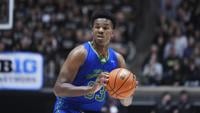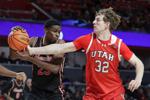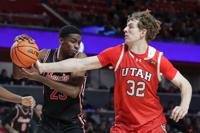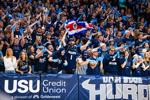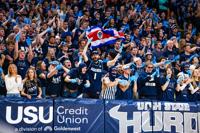LOGAN — With the Utah State men’s basketball roster set for the 2025-26 season, the tide of work for Jerrod Calhoun turns from constant recruiting and fundraising and toward actual basketball-related activities. Earlier this week, the now second-year coach sat down with local media to discuss the offseason, incoming players and his own offseason, which included his torn meniscus, a souvenir of his summertime hours spent playing pickleball and pick-up basketball in what little free time he’s had.
On Monday, May 12, Utah State men’s basketball head coach Jerrod Calhoun met with the media in the Estes Center. This is the full audio from that presser, focused primarily on the upcoming offseason, his efforts to raise NIL money for his roster and improvements he hopes to see from returning players.
Cache Valley Media Group
In his own words, Calhoun’s offseason hasn’t been the thrilling and exciting affair that his team’s 26-win season ended up being. He called it “probably been one of the worst (off-seasons) for me personally.” The need for raising NIL salary for his players has been a pressing constant. In an April 1 interview with the Full Court Press, Calhoun noted he’d spent the better part of the previous week raising funds. That wouldn’t be the last of his fundraising efforts this spring as he detailed on Monday.
“I was talking to Matt Painter [the head coach] from Purdue about this the other day,” Calhoun said on Monday. “He was nice enough to take my call. We talked for about 10 minutes. And at the Power Four (level), they’ve got to do some big fundraising events. Here it’s literally every day, five days a week. So in May, really middle of April and then all of May, all I’ve been doing is fundraising. Whether it’s Salt Lake, Cache Valley, you name it. We’re trying to raise dollars for our NIL because we don’t have revenue sharing money. So it’s been very, very stressful. It’s been a lot of hours, a lot of time.”
The need for NIL salary to be raised is greater than ever before as price points for players have skyrocketed. Even role players on major conference teams making seven-figure salaries. Calhoun estimated that prior to last year, a starting-caliber player in the Mountain West would command between $125,000 to $300,000. That price has gone up to a minimum of around $250,000 to as much as $1 million.
As much as the dramatically increasing cost has shocked Calhoun, he expressed how pleased he was to see just how much the Aggie community has stepped up their contributions to their local team. USU’s largest booster, Jim Laub, has written quite a few large checks, but Calhoun noted they have more than nine donors that have given more than $100,000 (“We couldn’t say that last year,” Calhoun said of that financial support). He specifically named Kevin White, Kent Alder and Laub as particularly helpful donors.
Even though Utah State can’t keep up in the arms race with the likes of the $10 million roster club schools, there’s an incremental increase in the Aggies standing among their peers. According to Calhoun, of the 37 at-large bid teams in last year’s NCAA Tournament, USU had the lowest roster budget at roughly $800,000. Achieving as much as they did on a low budget is quite the accomplishment, but Calhoun said “that’s not something we want to hang our hat on.” He’s aiming to get at least into the top four in spending in the Mountain West, something they weren’t last year but believes the Aggies will reach this season.
Finding all that money played a key role in retaining as many key players as Utah State has. Last year they lost five rotation players (Great Osobor, Josh Uduje, Kalifa Sakho, Javon Jackson, Max Agbonkpolo) to the transfer portal. This year, only one player that averaged at least 10 minutes per game transferred (Deyton Albury). There were losses, but rotation players have left almost exclusively via the traditional way, graduation, with Aubin Gateretse, Dexter Akanno and Ian Martinez leaving that way (technically, Martinez has entered the portal, but his ability to get another year of eligibility is questionable).
This year, the Aggies have five returning players — Drake Allen, Tucker Anderson, Jordy Barnes, Mason Falslev and Karson Templin, all of whom figure to be starters or staples of the rotation. And while they only comprise a third of the roster, Calhoun places a lot of importance on having these players return.
“I’m really grateful that we got five returning players,” Calhoun said. “I think there’s a lot of coaches out there that don’t have that luxury. So I’m really excited. I think they’re the most important guys in the program because they’ve been here. They’ve helped establish what we do day in and day out.”
Falslev is of particular interest, both internally with the team and fans but also externally to the Mountain West and region as a whole. The soon-to-be junior guard has a lot of expectations riding on his shoulders as he looks to make the next jump in his career. He’s been a contributor as a freshman, part of a star duo as a freshman, and potentially a solo star this year with a supporting cast of veterans and promising youth to back him up. Falslev is likely to be a top candidate for MW Preseason Player of the Year (Calhoun believes it’ll be either Falslev or San Diego State center Magoon Gwath). Players in the Mountain West have taken notable sophomore-to-junior jumps before. Sam Merrill went from averaging 16.3 points as a sophomore to 20.9 as a junior. New Mexico guard Donovan Dent did similarly going from 14.1 points two years ago to 20.4 this past season. Both Merrill and Dent won conference player of the year as juniors.
The Cache Valley native has already taken some jumps, going from an impressive 11.3 points as a redshirt freshman to 15.0 as a sophomore. He won conference player of the week honors four times last year and was named All-Mountain West Second Team. And yet there are areas of improvement. Calhoun noted that developing Falslev needs to develop his mid-range game, work more on using his left hand, and maintain the improvements he made in his jump shot (30.5 percent from three as a freshman to 39.0 percent last year). And Calhoun is confident his star guard will put in the work.
“I think the beautiful thing about him is he’s gonna put in the effort,” Calhoun said of Falslev.
A lot of players will ultimately need to make improvements. Among many things, 3-point shooting will need to be improved by nearly every Aggie. Drake Allen, Tucker Anderson and Karson Templin all shot below 30 percent from three this past season. As three of the five returners (and with the Aggies losing arguably their two best 3-point shooters, Martinez and Akanno), those numbers have to go up. You could also point to Zach Keller, MJ Collins and Garry Clark as guys who have 3-point shooting in their arsenal, but could stand to improve their percentages. Calhoun is confident in his own coaching abilities to get players to shoot better from outside.
“I don’t mean to sound cocky in this and don’t take it like this because I’m not really that type of guy. But every guy we’ve ever coached has shot better,” Calhoun said. “There’s not a guy that’s going to come in here and not shoot better. So if a guy’s shooting 31, 32 [percent], I bet you we get him 4 percentage points higher. And then you say, well, why is that? I think it’s scheme. I think it’s what we run. I think it’s all confidence. I think at the end of the day, life is all about confidence. We really empower these guys. Most coaches, they’ve got closer reign on offense. I think what makes good offense is total opposite. Let kids take and make shots in the offseason that they can’t. They’ll make them during the season. We did that at Youngstown [State] for years. We took guys who couldn’t shoot, come in our program. We told them they could shoot. We didn’t lie to him and then we let him shoot.”
Though Calhoun will lean on his returners, the newcomers will play a massive role as they have for the entirety of the modern transfer portal era. Much was made about the Aggies going after a dominant big, and while it didn’t result in the skilled 7-footer all coaches dream of, Calhoun is pleased with the ability of his two transfer bigs, Clark and Keller.
“Zach has real size. He’s every bit of 6’10”. He’s really, really big, and then he’s also skilled,” Calhoun said. “Garry’s not as tall, but Garry’s very versatile. Garry can do a lot of different things. So I think those two guys will give us a really good one-two punch.”
A lot will be leaning on those to players, along with Templin, as they could end up having to form a thin, three-man big rotation (depending on the viability of incoming freshman center David Iweze).
Shifting from transfers to freshman, Utah State’s 2025 recruiting class has been quite the heralded group, being the highest rated class in program history. Kingston Tosi, Adlan Elamin and Brayden Boe are all four-star recruits by ESPN’s rankings with Tosi and Elamin initially being four-star recruits by 247 Sports (which now lists both as three-star recruits and currently has no rating for Boe). Iweze and Elijah Perryman also clock in as three-star recruits. It’s a group filled with long-term potential.
Tosi, by even Calhoun’s own admission, is likely the most heralded of the group. His highlight-reel athleticism and potential for NBA size at the forward spot are an enticing combination.
“He can do it all. He can shoot threes. He’s long. He’s athletic. He’s got a motor,” Calhoun said of Tosi. “I think he’s a tremendous cutter. I think he’s an extremely gifted athlete. Comes from a competitive family. Dad played in the NFL. He competes. That’s one thing that I like.”
But even for these talented freshmen, Calhoun was quick to note there’s a high likelihood it takes them a while to catch up to the veteran players, saying it will probably take “3-4 months” for them to “settle in.” Several will likely have to redshirt, barring injuries that may call them into action early.



